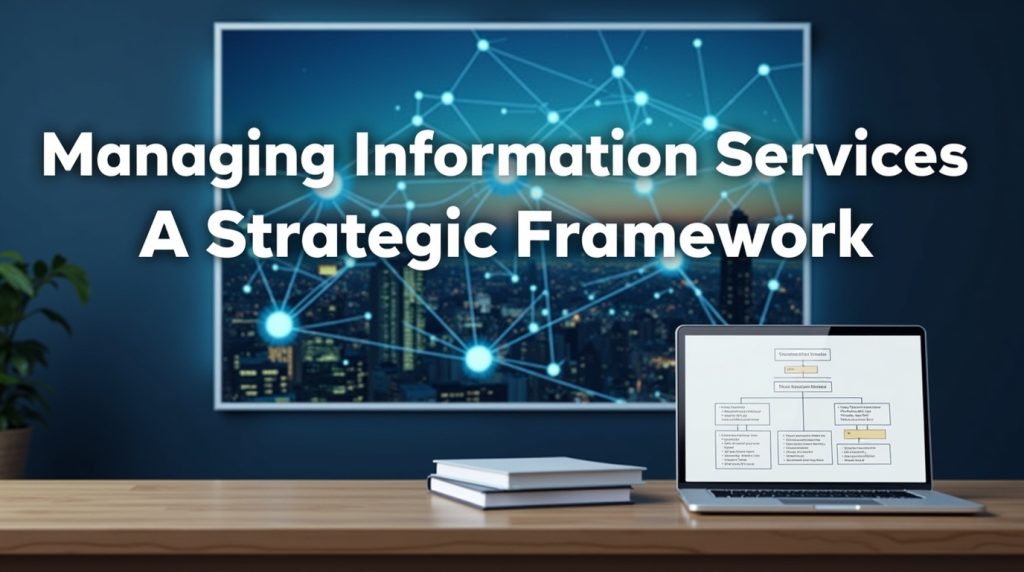As staff and data grow, the simple IT setup that works perfectly for a small team quickly becomes a major liability. This scaling hurdle creates critical gaps in security and compliance, which can lead to unexpected financial penalties and legal non-compliance. All of these problems are the actual expense of not managing information services. Failure to adapt to your digital environment means compromising reliability for growth.
Successfully managing information services demands a strategic, size-aligned framework built on legal trust. Here, we will provide the strategic framework you need to manage information services perfectly. Primarily, we will compare fully managed, co-managed, and internal models to ensure your digital operations are resilient, compliant, and strategically prepared for confident growth.
Key Takeaways
- As businesses grow, unmanaged information strategies can lead to security risks and legal non-compliance.
- Effective management of information services involves understanding the difference between IT service management and information management.
- Small organizations benefit from predictable support through managed services, focusing on cost efficiency and uptime.
- Large organizations require robust governance and specialized strategies for managing information services to mitigate risks.
- Choosing the right IT service model impacts your operational efficiency, control, and scalability for managing information services.
Table of Contents
- What Are Information Services and Why Do They Differ?
- A Practical Framework for Managing Information Services
- Choose the Right IT Service Model for Your Business
- Specialized Roles in Managing Information Services
- Building a Scalable Information Management Strategy
- Day-to-Day Tools Used by Information Services Managers
- Conclusion
- FAQs
What Are Information Services and Why Do They Differ?
Information services are the backbone of any modern organization. They cover all the systems, people, and processes that handle and deliver information internally. These services ensure your business runs smoothly every day. When managing information services, it is essential to distinguish between two main concepts: service delivery and data governance.
The Core Difference Between IT Service and Information Management
Most people think about IT services when their laptop breaks. This falls under Information Service Management (ISMS) or IT Service Management (ITSM). ITSM involves activities that IT teams perform to design, build, deliver, and support value to customers through technology. This includes tasks like setting up new email accounts, providing replacement hardware, and handling help desk tickets. ITSM is mostly operational and tactical. Its goal is to keep things working.
Information management services are broader. They focus on the strategic governance and protection of the actual data, not just the systems that hold it. This includes ensuring regulatory compliance, retaining institutional knowledge, and confirming data quality. High-level planning utilises robust management information services and systems for strategic oversight. They make sure the right data reaches the right decision-makers.
Why Size Changes Strategy?
The primary goal of a small business is simple: operational efficiency. They need information and service management that focuses on simple uptime. They want to ensure the email works and that files are accessible. If their server goes down, they lose revenue because they cannot operate. This is an operational failure.
A large organization, however, pivots its focus. Their top priority is focused on risk mitigation and achieving a competitive advantage. In the case of a large financial firm, for example, that breaches strict data privacy regulations. It faces massive regulatory fines and reputational damage; the main challenge shifts from technical failure to governance failure. Therefore, the larger the organization, the higher the priority of Information Management over routine daily IT Service Management. Effective management of information services acknowledges this critical pivot point.

A Practical Framework for Managing Information Services
We need a separate framework for small and large organizations. What works for a small startup is guaranteed to fail a large enterprise. This section details the specific strategies and frameworks necessary for each size.
Small Organizations Need Predictable Support
Small and medium businesses (SMBs) consistently struggle with the same things. They face tight budget constraints and often cannot afford the high fixed costs of specialized, full-time IT staff. They usually focus on fixing immediate problems rather than investing in long-term risk management. Additionally, they lack the expertise required for complex security or strategic planning.
The practical solution for managing information services in a small company is external help. This involves outsourcing daily IT needs to providers of managed information services. These providers offer managed information technology services that provide enterprise-level tools and expertise at predictable monthly rates.
To set up a minimalist framework, SMBs should adopt a streamlined approach to ITSM. They can implement basic components of the Information Technology Infrastructure Library (ITIL). This approach focuses primarily on Incident Management (fixing what is currently broken) and Service Request Management (providing new tools or access). This scalable setup forms a reliable system for managing service information. Offering affordable information management service delivery is key to their success. When managing information services on a tight budget, simplicity and predictability are your best allies.
Large Organizations Require Governance and Specialization
Large organizations require highly mature, tailored strategies for managing information services. They struggle with complexity, internal silos, and the necessity of specialized compliance. Their strategy must focus on compliance and competitive advantage.
Large-scale organizations require formal governance frameworks, such as COBIT (Control Objectives for Information and Related Technologies). COBIT helps align vast IT strategies with highly specific, overarching business goals. This provides the clear structure necessary for massive scale.
At this level, information security management services are absolutely non-negotiable. Large firms utilize advanced Security Information and Event Management (SIEM) solutions. SIEM collects and analyzes massive volumes of data from devices and apps in real-time. This enables security teams to detect and respond to threats quickly across the organization’s extensive digital footprint. This is an important component of the overall information technology management service.
For large retailers or manufacturers, maintaining data integrity across multiple sales channels is crucial. They require product information management services (PIM). PIM centralizes all product specifications, images, and marketing assets. Without a robust PIM, data errors can lead to significant revenue loss across various e-commerce platforms.
Furthermore, large financial institutions must adhere to strict regulatory rules enforced by agencies. This requires careful alignment of technical precision (data governance) with legal adherence (information governance) when managing information in the financial services sector. Successfully managing information services here means avoiding legal pitfalls.

Choose the Right IT Service Model for Your Business
When strategizing for managing information services, it is essential to choose the right operational model. This choice directly determines your cost structure, your level of control, and how easily you can scale the business. The three primary models are fully outsourced, collaborative, and fully internal.
Fully Managed Information Technology Services
This is the standard model for small businesses. It involves completely outsourcing IT to a Managed Service Provider (MSP). The MSP manages everything: the help desk, continuous network monitoring, software updates, and basic security. The key benefit is that it provides predictable, flat-rate costs and is easily scalable. This approach frees the business owner from the daily stress of IT operations.
Co-Managed Information Technology Services
This model is ideal for mid-sized organizations. Co-managed information technology services create a partnership. They complement an existing internal IT team that might be overworked or lack specific expertise.
The internal team keeps control over core strategy and specific systems. The MSP steps in to handle augmentation tasks. This might include 24/7 monitoring, specialized cybersecurity measures, or executing large infrastructure projects. This prevents the internal team from burning out. It allows them to focus on strategic initiatives that directly affect business growth.
In-House IT Management
This model requires the highest fixed costs. You must pay salaries, benefits, and invest in infrastructure and training. However, it offers maximum control and the deepest integration with day-to-day business operations. Scaling an in-house team is slow. It involves hiring and training, making it difficult to adapt quickly to rapid changes in business demands.
Service Model Alignment
The biggest risk in the co-managed information technology services model is blurred responsibility. If you do not clearly define who owns which task, the internal team and the MSP will waste time pointing fingers when issues arise. This model requires a highly skilled internal information services manager. This manager acts as the single point of contact. They ensure clear accountability and define access protocols. Successful co-management requires robust governance, often integrated through access information management shared services (AIM) practices.
Comparing IT Service Models for different-sized organizations.
| Feature | Small Org (Fully Managed) | Mid-Size Org (Co-Managed) | Large Org (In-House/Hybrid) |
|---|---|---|---|
| Primary Goal | Stability, Cost Predictability | Staff Augmentation, Strategy Focus | Governance, Competitive Advantage |
| Service Model | Managed Information Technology Services | Co-Managed Information Technology Services | Internal + Specialized Vendor Contracts |
| Cost Structure | Predictable Monthly Fee (OpEx) | Variable (Based on Tasks/Coverage) | High Fixed Salaries and Infrastructure (CapEx) |
| Control Level | Outsourced (Low Internal Control) | Collaborative (Shared Control) | Internal (High Control) |
| Framework Focus | Basic ITIL (Incident/Request) | Scaled ITIL, Project Management | COBIT, NIST, Comprehensive ITSM |
Specialized Roles in Managing Information Services
As an organization grows and its digital demands increase, the job of the general IT manager splits into specialized functions. These specialized roles are essential for effectively managing information services at scale.
The Internet Information Services Manager
In large environments, web server reliability is paramount. The Internet Information Services manager handles this specialized area. This role uses tools like IIS Manager to provide centralized management of multiple websites and applications. The manager ensures high-performance web applications, sets critical security configurations, and manages remote administration securely. This is essential to any organization that relies heavily on external-facing web apps or e-commerce.
The Value of Access Information Management Shared Services
Large, complex, or geographically dispersed organizations often adopt access information management shared services. This centralizes the management of the entire information lifecycle. This involves handling everything from creating a document to its secure destruction. This service breaks down data silos and ensures consistent access and records management across the whole enterprise. This consistency is crucial for compliance and governance, particularly in highly regulated industries.

Building a Scalable Information Management Strategy
Scaling IT means building systems and processes that can handle future demands without compromising performance or failing. These are the essential principles to consider when setting out a strategy for managing information services.
Key Principles for Scalability
- First, ensure that your IT strategy aligns with your business objectives. When your business has global expansion plans, cloud solutions, and scalable infrastructure should take priority in your IT investments. Your IT management service should support your growth path.
- Second, adopt a Cloud First approach. Cloud solutions offer flexibility, predictable costs, and elasticity. They remove the need for massive upfront hardware investments.
- Third, automate routine tasks. Automating processes such as invoicing, customer management, or workflow approvals saves time and minimizes human error. This frees your professional staff to work on more valuable tasks.
This is how you make sure that managing information services acts as a catalyst for growth, rather than a heavy administrative burden.
Using a Reliable Service Information Management System
Regardless of your size, you need an effective service information management system. This platform centralizes support requests, tracks incidents, and ensures business continuity.
For a small firm, a simple ticketing platform is enough. For a large enterprise, this system must integrate capabilities like knowledge management, configuration management, and complex change management. This comprehensive system is crucial for delivering quality service information management at scale.
Day-to-Day Tools Used by Information Services Managers
What tools are actually used on the ground every day? The specific tools depend on the size and service model.
Essential Tools Across the Board
- Ticketing Systems: These are non-negotiable. Tools such as Jira or ServiceNow are used for logging every support request. They monitor time spent on issues and produce reports. These reports are essential for justifying headcount or proving the value of outsourcing costs to senior leadership.
- Remote Monitoring and Management (RMM): Both MSPs and large internal teams use RMM tools. These continuously monitor system health. They monitor potential issues and perform patching or updates before the users even realize that there was a problem.
Tools for Specialized Organizations
- SIEM Solutions: Primarily used by large enterprises. Security Information and Event Management (SIEM) aggregates and analyzes massive data volumes from all network devices in real-time. This provides crucial visibility into the security posture and aids comprehensive information security management services.
- PIM Platforms: Essential for large e-commerce and manufacturing businesses. PIM platforms ensure the integrity of vast and complex datasets across multiple distribution channels.
Successfully managing information services means choosing tools that simplify workflows. It means empowering your team, whether internal or external, to be proactive rather than just reactive.
Conclusion
Successfully managing information services requires alignment. Your IT strategy must align with your organization’s size, complexity, and specific compliance requirements. Never invest in technology until you understand your current maturity level, budget constraints, and legal obligations.
For smaller companies, the practical framework focuses on outsourcing routine tasks to gain stability and cost predictability through managed information services. This frees up resources to focus on revenue. For larger enterprises, the framework requires formal governance, specialized roles, and significant internal investment, often boosted by strategic vendors providing specialized information security management services.
This guide provides a practical, flexible framework, rather than a rigid rulebook. Continuously reassess your needs. When your current solution causes stress or slows growth, it signals time for a strategic pivot. Effective management of information services ensures IT becomes a catalyst for competitive growth, not a source of operational drag.
FAQs
IT Service Management (ITSM) is the practice used by IT teams to manage the end-to-end delivery of IT services to users. It encompasses operational processes such as incident management, handling service requests, and ensuring that all underlying systems run efficiently and reliably.
Small businesses often lack the budget and specialized expertise to support a full-time internal IT staff. Information technology managed services provide affordable access to enterprise-level security tools, 24/7 monitoring, and expert support at a fixed, predictable monthly fee. This enables the business to focus on core operations without the distraction of constantly managing internal information services.
The most valuable services for a small business include proactive monitoring, robust network security and threat protection, reliable data backup and disaster recovery, and accessible help desk support. These services minimize risk and maximize vital operational uptime.
They use cloud solutions to manage the services efficiently. Cloud platforms lower the need for costly, upfront on-premise hardware investments. The majority of routine IT support is also outsourced to a Managed Service Provider (MSP) by small businesses. This shifts major capital expenditure to predictable monthly operating expenditure.
Managers rely heavily on professional ticketing systems for logging and tracking support requests. They use Remote Monitoring and Management (RMM) tools for proactive maintenance. Large organizations also utilize SIEM platforms for real-time security analysis, as well as PIM systems that specialize in data consistency.











